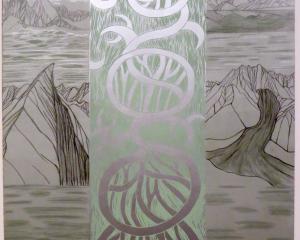This week, Sam McKegg reviews works by Billy Apple and Dr. Craig Hilton, Kate Davis, and Andy Leleisi'uao.
The Analysis of Billy Apple's Genome is the latest work from an ongoing project between Billy Apple and scientist and artist Dr Craig Hilton that questions ethical and cultural issues surrounding the use of body tissue and genetic information.
In 2009, Apple's I Consent saw the artist consent to the unrestricted distribution and use of his cell lines derived from blood. Apple's cells have become a living artwork, and are available through the American Type Culture Collection, a biological culture repository, for use by both artists and scientists.
As a continuation of this project, The Analysis of Billy Apple's Genome presents a Circos diagram of Apple's sequenced genome. The diagram shows selected analysis of Apple's 22-paired chromosomes plus two male chromosomes. The work appears to focus on Apple's genetic vulnerabilities and predisposition to diseases including cancer, heart disease and diabetes.
First exhibited in 2014, this iteration sees the diagram printed on PVC and hung on the Public Art Gallery's "Big Wall'' alongside two printed canvases. These are a copy of I Consent and Totality, which present terms relating to data analysis.
With plenty of wall space available, it is tempting to suggest the work could have been presented in a larger scale. However, the project remains an interesting and timely exhibition, with the New Zealand Science Festival next month.
Also at the Dunedin Public Art Gallery is Kate Davis' The Unswept Floor. The New Zealand-born, Glascow-based artist is the gallery's most recent international visiting artist. The exhibition presents a survey of Davis' practice alongside a new series produced during her Dunedin residency.
A selection of Davis' film and pictorial work is placed around the walls of the gallery, with her most recent work mounted in the centre on temporary hanging racks. Davis' concerns in feminism, art history and the roles of women in art emerge across the numerous and varied works.
Davis regularly uses other artists' works to form responses to historic figures and practices. Disgrace is a film and series of drawings that reproduce and respond to nudes by Amedeo Modigliani.
Also concerning the reproduction of art, Curtain I-VII and Reversibility look at the implications of preserving art and how restoration and storing practices affect original artworks.
Davis' new work On Sensitive Ground connects domestic activity with the process of print making in an intriguing series of etchings. The abstract black-and-white images are representations of the marks left by the actions found in a home setting, such as cleaning, eating and sleeping.
Connecting her wider practice to New Zealand art, Davis displays her new works alongside a group of works by other artists from local collections that share similar conceptual concerns.
Andy Leleisi'uao draws from the styles of classical Greek vases, Egyption hieroglyphs, cave art and Samoan siapa cloth to produce distinctive figurative works.
His works feature a multitude of human and creature figures, as a community that appears to be busy at work. Lelesi'uao's works are multi-storied, with layered bands of figures that produce hive-like scenes.
Among the scenes are varying scales of figures, with some of the larger works showing what become giants compared with smaller counterparts. Also distinguishing figures are markings, including circles and puzzle pieces, but now clues are given to the marks' meanings.
There are skeletal forms, four-legged beasts and ungrounded, floating forms. The variety of figures is surprising, considering Leleisi'uao's restricted colour palette. The works are predominantly in black and white, but the addition of one or two colours in each piece highlight details and differences between the works.
Leleisi'uao's paintings are intriguing as the works have strong narratives, but they are ultimately cryptic and confusing. The works invite viewers to read them from left to right, like a comic strip, but the story that emerges is entirely up to the viewers' interpretation as details and intricacies only work to further confound the scenes.
-By Sam McKegg







![Untitled (c. mid 1990s, [pink 3]), by Martin Thompson, 415mm×590mm. Photo: courtesy of Brett...](https://www.odt.co.nz/sites/default/files/styles/odt_landscape_small_related_stories/public/story/2024/02/untitled_pink_3.jpg?itok=Q0aQrc9o)




